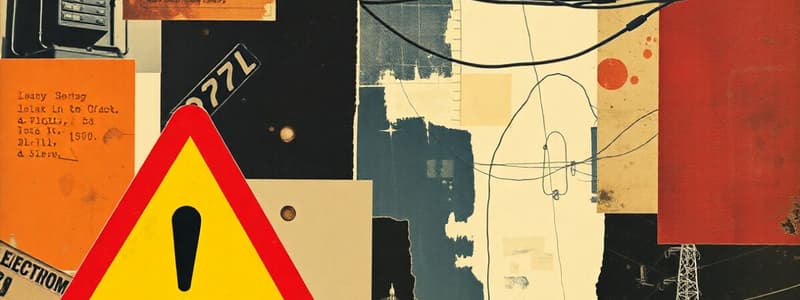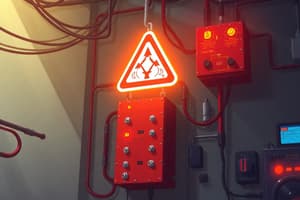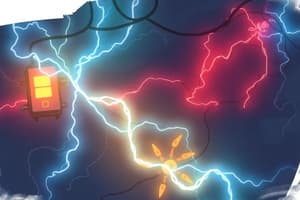Podcast
Questions and Answers
What was a major contributing factor to the incident involving the worker and the overhead powerline?
What was a major contributing factor to the incident involving the worker and the overhead powerline?
- The boom truck operator's view might have been obstructed. (correct)
- A signaler was used effectively during the procedure.
- The company had designated a safe unloading area.
- The worker was wearing appropriate personal protective equipment.
Which electrical hazard type involves the danger of electricity entering the human body?
Which electrical hazard type involves the danger of electricity entering the human body?
- Electrical fires.
- Arcing incidents.
- Overloading circuits.
- Electrical shock. (correct)
What should a company ensure to prevent incidents like the one involving the apprentice and the electrical panel?
What should a company ensure to prevent incidents like the one involving the apprentice and the electrical panel?
- Regularly update equipment to the latest technology.
- Provide appropriate safety training and supervision. (correct)
- Limit access to the electrical panels only to apprentices.
- Ensure all panels are kept permanently de-energized.
What was a neglectful practice that led to the apprentice's fatal injury?
What was a neglectful practice that led to the apprentice's fatal injury?
Which of the following mechanisms describes how electrical shock can occur?
Which of the following mechanisms describes how electrical shock can occur?
Which human factor was identified as a contributor to the worker’s shock incident?
Which human factor was identified as a contributor to the worker’s shock incident?
What can be a consequence of even mild electrical shock?
What can be a consequence of even mild electrical shock?
What is one of the main types of electrical hazards that can cause serious property damage?
What is one of the main types of electrical hazards that can cause serious property damage?
What is a significant consequence associated with electrical accidents?
What is a significant consequence associated with electrical accidents?
Which of the following is NOT a type of electrical hazard?
Which of the following is NOT a type of electrical hazard?
What is the primary cause of electrical incidents?
What is the primary cause of electrical incidents?
How does the injury-to-fatality ratio of electrical incidents compare to other occupational injuries?
How does the injury-to-fatality ratio of electrical incidents compare to other occupational injuries?
Which statistic indicates the severity of injuries from electrical incidents?
Which statistic indicates the severity of injuries from electrical incidents?
What type of loss is particularly high as a result of electrical incidents in Canada and the United States?
What type of loss is particularly high as a result of electrical incidents in Canada and the United States?
Which statement best describes the relationship between electricity and safety in engineering?
Which statement best describes the relationship between electricity and safety in engineering?
What does the term 'hierarchy of controls' refer to in relation to electrical hazards?
What does the term 'hierarchy of controls' refer to in relation to electrical hazards?
What is defined as the flow of current through an insulating medium that is accompanied by light, heat, and sound?
What is defined as the flow of current through an insulating medium that is accompanied by light, heat, and sound?
Which of the following factors does NOT contribute to the intensity of an arcing incident?
Which of the following factors does NOT contribute to the intensity of an arcing incident?
What can happen to a person standing several feet away from an arc flash?
What can happen to a person standing several feet away from an arc flash?
At what temperature can an electric arc potentially reach?
At what temperature can an electric arc potentially reach?
What is the main cause of electrical fires?
What is the main cause of electrical fires?
Why do electrical fires occur more frequently in homes than in commercial or industrial facilities?
Why do electrical fires occur more frequently in homes than in commercial or industrial facilities?
What severe consequence can occur from inhaling vapour produced by an arc blast?
What severe consequence can occur from inhaling vapour produced by an arc blast?
What is a common cause of arcing that can lead to electrical fires?
What is a common cause of arcing that can lead to electrical fires?
What is over-fusing in electrical systems?
What is over-fusing in electrical systems?
Which method is considered the most effective in controlling electrical hazards?
Which method is considered the most effective in controlling electrical hazards?
Which principle of inherent safety involves using a less hazardous form of a material?
Which principle of inherent safety involves using a less hazardous form of a material?
What is an example of an engineering control for managing electrical hazards?
What is an example of an engineering control for managing electrical hazards?
What type of control would prohibit the use of extension cords in an organization?
What type of control would prohibit the use of extension cords in an organization?
Which of the following is NOT an example of personal protective equipment?
Which of the following is NOT an example of personal protective equipment?
Which hierarchy of controls focuses on modifying processes to eliminate high voltage requirements?
Which hierarchy of controls focuses on modifying processes to eliminate high voltage requirements?
What does moderation as an inherently safer design principle involve?
What does moderation as an inherently safer design principle involve?
Flashcards
Electrical Hazards
Electrical Hazards
Dangerous situations involving electricity that can cause harm to people or property.
Types of Electrical Hazards
Types of Electrical Hazards
There are three main types of electrical hazards: electrical shock, arcing and electrical fires.
Electrical Shock
Electrical Shock
A sudden discharge of electricity through a person's body, causing a painful sensation or serious injury.
Arcing
Arcing
Signup and view all the flashcards
Electrical Fires
Electrical Fires
Signup and view all the flashcards
Hierarchy of Controls
Hierarchy of Controls
Signup and view all the flashcards
Elimination (Hierarchy of Controls)
Elimination (Hierarchy of Controls)
Signup and view all the flashcards
Substitution (Hierarchy of Controls)
Substitution (Hierarchy of Controls)
Signup and view all the flashcards
Direct Contact (Electrical Hazard)
Direct Contact (Electrical Hazard)
Signup and view all the flashcards
Step/Touch Potential (Electrical Hazard)
Step/Touch Potential (Electrical Hazard)
Signup and view all the flashcards
Reverse Polarity (Electrical Hazard)
Reverse Polarity (Electrical Hazard)
Signup and view all the flashcards
Arcing Incident (Electrical Hazard)
Arcing Incident (Electrical Hazard)
Signup and view all the flashcards
Electrical Fire (Electrical Hazard)
Electrical Fire (Electrical Hazard)
Signup and view all the flashcards
Human Factors in Electrical Incidents
Human Factors in Electrical Incidents
Signup and view all the flashcards
Controlling Electrical Hazards
Controlling Electrical Hazards
Signup and view all the flashcards
What is an electrical arc?
What is an electrical arc?
Signup and view all the flashcards
What is an arc blast?
What is an arc blast?
Signup and view all the flashcards
What is incident energy?
What is incident energy?
Signup and view all the flashcards
How does an arc flash affect the body?
How does an arc flash affect the body?
Signup and view all the flashcards
What factors influence the severity of an arc flash?
What factors influence the severity of an arc flash?
Signup and view all the flashcards
What are the main causes of electrical fires?
What are the main causes of electrical fires?
Signup and view all the flashcards
How do wiring alterations contribute to electrical fires?
How do wiring alterations contribute to electrical fires?
Signup and view all the flashcards
Why are electrical fires more common in homes?
Why are electrical fires more common in homes?
Signup and view all the flashcards
Over-fusing
Over-fusing
Signup and view all the flashcards
Overheating of Extension Cords
Overheating of Extension Cords
Signup and view all the flashcards
Inherent Safety (Minimization)
Inherent Safety (Minimization)
Signup and view all the flashcards
Inherent Safety (Substitution)
Inherent Safety (Substitution)
Signup and view all the flashcards
Inherent Safety (Moderation)
Inherent Safety (Moderation)
Signup and view all the flashcards
Inherent Safety (Simplification)
Inherent Safety (Simplification)
Signup and view all the flashcards
Engineering Controls (Example)
Engineering Controls (Example)
Signup and view all the flashcards
Administrative Controls (Example)
Administrative Controls (Example)
Signup and view all the flashcards
Study Notes
Electrical Hazards and Controls
- This module is about the dangers of electricity and control measures
- The learning objectives are to identify dangers associated with electricity, describe the main types of electrical hazards, and explain the hierarchy of controls for electrical hazards
- Electricity is essential to modern life but also dangerous
- Electrical accidents cause significant property damage, injuries, and loss of life.
- Electrical hazards include electrical shock, arcing, and electrical fires
- Electrical incidents often stem from human error or inadequate safety practices.
- Electrical accidents are costly, with annual figures in Canada and the US indicating substantial property damage, injuries, and deaths.
- Electrical shock occurs when electricity enters the human body, completing a circuit. Currents under one amp can be fatal.
- Arcing is a flow of current through an insulating medium (air) accompanied by light, heat, and sound.
- Electrical fires are a common cause of fatalities related to electrical incidents. They result from misuse and poor maintenance of electrical equipment, rather than faulty design.
- Electrical fires often result from arcing and overheating.
- Causes of electrical fires include faulty outlets, old wiring, overloaded circuits, and short circuits.
- The hierarchy of controls is a method for managing risks, with five steps: elimination, inherent safety, engineering controls, administrative controls, and personal protective equipment.
- Elimination is the most effective control, removing the hazard altogether.
- Inherent safety involves designing equipment to minimize or exclude hazards.
- Engineering controls use physical barriers or tools to reduce exposure to hazards (e.g., safety equipment for jobs that are dangerous)
- Administrative controls affect how the work is done to prevent accidents (e.g., training, procedures, rules).
- Personal protective equipment (PPE) is the least effective control, providing safety gear for workers (e.g., insulated gloves).
- Electrical hazards can be controlled through proper awareness, appropriate preventative measures, and safe work practices.
Studying That Suits You
Use AI to generate personalized quizzes and flashcards to suit your learning preferences.




